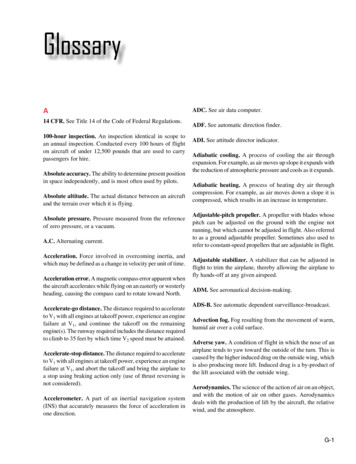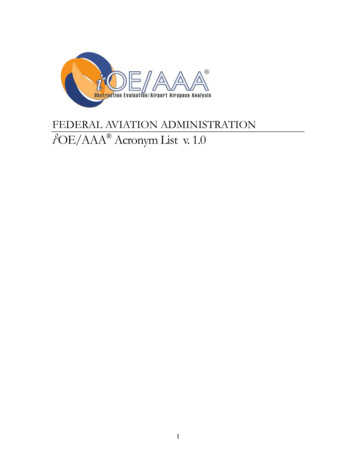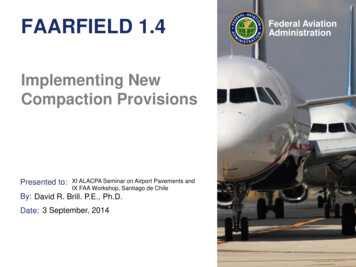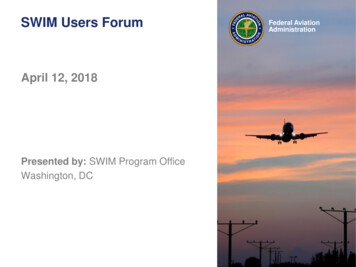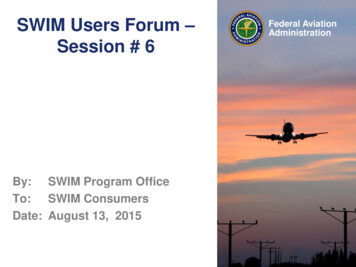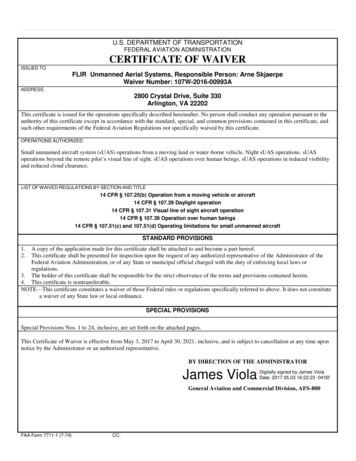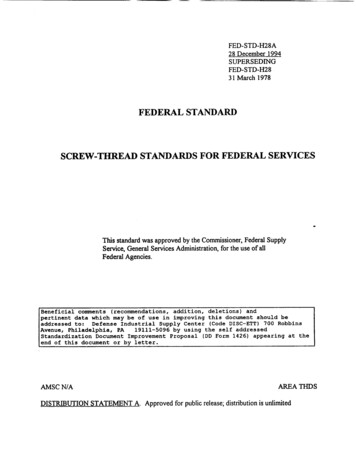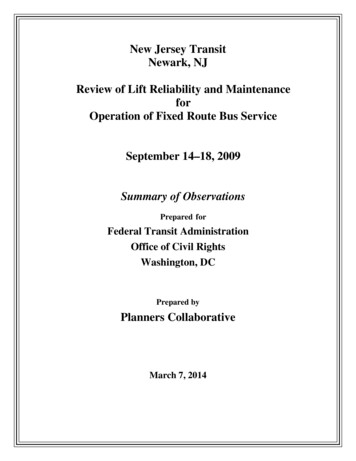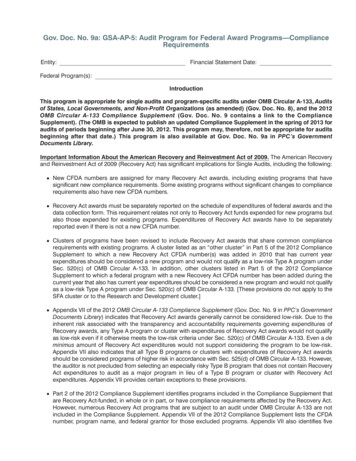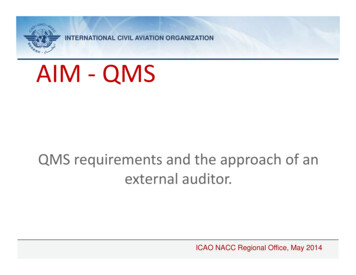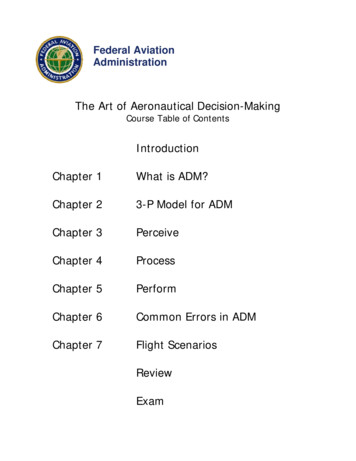
Transcription
Federal AviationAdministrationThe Art of Aeronautical Decision-MakingCourse Table of ContentsIntroductionChapter 1What is ADM?Chapter 23-P Model for ADMChapter 3PerceiveChapter 4ProcessChapter 5PerformChapter 6Common Errors in ADMChapter 7Flight ScenariosReviewExam
The Art of Aeronautical Decision-Making1IntroductionLife is full of decisions. Some (e.g., deciding what to wear towork) are so routine that we are hardly aware of makingthem. Others (e.g., changing jobs) take more effort becausethey have significant and lasting implications.Flying is also full of decisions. Many may appear to beroutine, but even “small” decisions made in the cockpit canhave a large impact on flight safety. Good aeronautical decision-making (ADM) istherefore an essential pilot skill.This course offers a practical framework to help you develop this vital pilot skill and useit to stay safe in all of your flying activities. After completing the course, you will beable to explain the 3-P model and apply it to flight scenarios that appear in Chapter7.At the end of the course is a short quiz drawn primarily from these scenarios. The pointof the quiz is to give you a chance to practice applying the 3-P model to flight scenarios.Just as in the real world, there may not always be a single “right” answer to quizquestions. If your answer differs from the official "right" answer, you may want todiscuss some of the questions and answers with a flight instructor or another pilot. Themost important thing is to understand how, and why, you reached the answer youprovided.
The Art of Aeronautical Decision-Making2Chapter 1 – What is Aeronautical Decision-Making?Aeronautical SkillsTo fly an airplane safely, you need three sets of separate, but related, skills.Physical Airplane . You need basic stick-and-rudder skills to safelycontrol the airplane itself. When you learn to fly; work on a new pilotcertificate, rating, or endorsement; or transition to a new airplane, theemphasis naturally tends to fall on maneuvers (“airwork”) that help youdevelop the necessary “physical airplane” skills.Mental Airplane . You need to thoroughly understand and correctlyoperate the various aircraft systems, which some experts characterize asthe “mental airplane” component. These include avionics, hydraulics,fuel, electrical, and other systems that help you aviate, navigate, andcommunicate.Aeronautical Decision-Making (ADM). Many pilots get in trouble notbecause of deficient “physical airplane” or “mental airplane” skills, butbecause of faulty ADM and risk management skills. Why should that beso? One reason is that ADM, unlike physical airplane and mentalairplane skills, is an invisible process. An instructor or examiner caneasily observe and evaluate your ability to land the aircraft (physicalairplane) or your proficiency in programming the GPS (mental airplane).ADM, on the other hand, is a process that takes place inside the pilot’sbrain. Because ADM is harder to observe and evaluate than basic aircraft control andsystems skills, it sometimes gets less emphasis than it deserves.ADM DefinedSo what exactly is ADM? In AC 60-22, the FAA defines ADM as aSystematic approach to the mental process of evaluating a given set ofcircumstances and determining the best course of action.Although this sentence provides a good description of the ADM process, you may beasking yourself how to translate this formal definition into practices that you can easilyuse in real world flying. Let’s take a look at one approach.Related Media for this SectionAC 60-22 on Aeronautical Decision-Making AC 60-22.pdf (2.74 MB)
The Art of Aeronautical Decision-Making3Chapter 2 – The 3-P Model for ADMPerceive, Process, PerformTo help pilots put the concept of ADM into practice, the FAA Aviation Safety Programdeveloped a new framework for aeronautical decision-making and risk management:Perceive – Process – Perform.This model offers a simple, practical, and systematic approach toaccomplishing each ADM task during all phases of flight. To use it, you:Perceive the “given set of circumstances” for your flight.Process by evaluating their impact on flight safety.Perform by implementing the best course of action.The next few chapters will describe how you put each of these steps into practice.Related Media for this Section3-P Model for Aeronautical Decision-Making 3P Risk Management Process.pdf (47.01 KB)
The Art of Aeronautical Decision-Making4Chapter 3 – PerceiveDevelop Situational AwarenessTo navigate to a particular destination, the first step is to determine exactly where youare right now. The same principle applies in ADM: to navigate to a safe outcome, youfirst need to understand the “given set of circumstances” you face.The first step in the 3-P model, PER CEI VE , is about developing a clear andcomprehensive awareness of your particular situation. Consider:For each element, ask “what could hurt me, my passengers, or my aircraft?”All four elements combine and interact to create a unique situation for any flight. Payspecial attention to the pilot-aircraft combination, and consider whether the combined“pilot-aircraft team” is capable of the mission you want to fly. For example, you may bea very experienced and proficient pilot, but your weather flying ability is still limited ifyou are flying a 1970s-model aircraft with no weather avoidance gear. On the otherhand, you may have a new technically advanced aircraft with moving map GPS, weatherdatalink, and autopilot – but if you do not have much weather flying experience orpractice in using this kind of equipment, you cannot rely on the airplane’s capability tocompensate for your own lack of experience.
The Art of Aeronautical Decision-Making5Chapter 4 – ProcessEvaluate with CARENext, you mentally PROCESS information about the circumstances that you haveidentified. The goal is to evaluate their impact on the safety of your flight, and consider“why must I CARE about these circumstances?”For each hazard that you perceived in step one, process with CARE. Example: for anight flight to attend a business meeting:Consequences (e.g., departing after afull workday creates fatigue & pressure)Alternatives (e.g., delay until morning;reschedule meeting; drive)Reality (e.g., dangers and distractionsof fatigue could lead to an accident)External pressures (e.g., businessmeeting at destination might influenceme)A good rule of thumb for the processing phase: if you find yourself saying that it will“probably” be okay, it is definitely time for a solid reality check.If you are worried about missing a meeting, be realistic about how that pressure willaffect not just your initial go/no-go decision, but also your inflight decisions to continuethe flight or divert.
The Art of Aeronautical Decision-Making6Chapter 5 – PerformMitigate, Eliminate, EvaluateOnce you have perceived a hazard (step one) and processed its impact on flight safety(step two), it is time to PERFORM by taking the best course of action, and thenevaluating its impact. Your goal is toYour mental willingness to follow through on safe decisions, especially those that requiredelay or diversion is critical. You can bulk up your mental muscles by: Using personal m inim um s check list to make some decisions in advance of theflight. If you are unsure of how to develop personal minimums, take a look at themethods presented in the three documents below. Choose one that works for you,and stick to it! Develop a list of good alternatives during your processing phase. In marginalweather, for instance, you might mitigate the risk by identifying a reasonablealternative airport for every 25-30 nm segment of your route. Preflight your passengers by preparing them for the possibility of delay anddiversion, and involve them in your evaluation process. Download the PassengerPreflight Checklist below for specific ideas.Related Media for this SectionPersonal and Weather Risk Assessment Guide Personal and Wx Risk Assessment Guide V1.0.pdf (1.03 MB)PAVE Personal Minimums Checklist Personal Minimums Checklist.pdf (154.92 KB)Personal Minimums Worksheet Personal Minimums Worksheet.pdf (31.04 KB)Passenger Preflight Checklist Preflighting Your Passengers.pdf (24.79 KB)
The Art of Aeronautical Decision-Making7Chapter 6 – Common Errors in ADMTypes of Pilot ErrorPilot mistakes are often called “pilot error,” formally defined as:An action or inaction that leads to a deviation from intentions and expectations.Sometimes, pilot error involves deficiencies in aircraft control, or "physical airplane,"skill. These errors can be prevented through maneuvers-based training and practice.In other cases, accidents attributed to pilot error result from shortcomings in the pilot's"mental airplane" systems knowledge. Examples might include misprogramming theautopilot, or turning the wrong knob on the GPS navigator. Use of aircraft trainingdevices, computer-based training, and regular practice in the aircraft can help preventthese errors.Since this course focuses on aeronautical decision-making, this chapter will take a closerlook at factors involved in "decisional errors," which usually involve a combination ofcognitive activities and judgments.Effects of Human LimitationsHuman limitations can play a significant role in how we perceive, process, and performin complex activities, like flying. For example:Filtering: The brain's working memory capacity is limited to about seven (7) pieces, or“chunks,” of information at one time, so one of the life skills we acquire is the ability tofilter the flood of information arriving through our senses. In any flight, especially onewith challenging weather, we may unconsciously screen out vital information. Use ofthe PAVE checklist as a guide to your ongoing mental hazard scan can help preventinappropriate filtering, because it provides a comprehensive and methodical approach tothe information gathering process.Filling in the Gaps: When there is more information than the brain can accuratelyperceive and process, it compensates by filling in the gaps and producing aninterpretation that is not correct.
The Art of Aeronautical Decision-Making8Take a look at the corridor illustration below.The brain quickly processes the information in thisillustration and concludes that the cylinders in thepicture are different heights, and that they appear to begrowing larger from left to right.In fact, however, they are all the same size.Runway illusions, which can result in unsafe decisionswhen flying an approach, are a good example of thistype of human error.Patterns and Expectations: The brain uses existing knowledge and experience as ashortcut to processing new information. This tendency can be useful, but it can also bedangerous. Examples: When you are processing information from an unfamiliar GPS navigator, youmight unconsciously make incorrect assumptions on the basis of how informationis accessed or displayed on the one you normally use.If previous experience at a familiar airport leads you to expect a clearance toland on runway 10, you may "hear" a clearance to land on “one-zero,” even ifthe controller in fact clears you to land on runway 01.Confirmation Bias: Human beings also have a tendency to look for information thatconfirms a decision we have already made. For example, imagine that you havedecided to continue a flight you have already started. You call Flight Watch for updatedweather information on several nearby airports, but you might unconsciously give moreweight to the information that supports your decision to press ahead.The "reality" part of the systematic ADM process is especially useful in countering errorsassociated with patterns, expectations, and confirmation bias. Make a conscious effortto identify your expectations, and then be alert to how reality differs.Framing: When you evaluate options for a decision, be sensitive to how you state, or"frame," your alternatives. Assume you are deciding whether to continue a flight indeteriorating weather. If you frame the “continue” decision in positive terms (e.g., “Ican save a lot of time and inconvenience if I go on”), you are probably more likely todecide on continuing. If, on the other hand, you frame the decision in negative terms
The Art of Aeronautical Decision-Making9(e.g., “I could get myself in real trouble if I push on”), you are more likely to divert to asafer destination.Error Prevention, Detection, and ManagementNo matter how hard we try, it is simply not possible for human beings to avoid errorsentirely, especially when complex systems are involved. By using a systematic approachto continuous ADM, however, and developing awareness of common types of humanADM error, we can seek to minimize mistakes.Consistent use of these tools can also help with quick recognition of errors we do make,and safe management of the resulting situation.
The Art of Aeronautical Decision-Making10Chapter 7 –Flight ScenariosADM Flight ScenariosDownload the document below, which contains several flightscenarios that require the use of decision-making skills. Thesescenarios are the primary basis of the course exam, so you willwant to have them available as you go through the quiz. Readthrough each one, and use the 3-P model to develop situationalawareness (perceive), evaluate risk (process), and consider thedecisions you would make (perform) in similar circumstances.Most of the quiz questions ask you to use scenario information to choose the responsethat you believe to be the best, or most complete, answer for each multiple-choicequestion.You m ay not alw ays agree w ith the official "correct" answ er, and you m ayhave a very good reason for choosing a different response .If your responses differ, you might find it interesting to discuss the scenarios, and yourreasoning, with an instructor or another pilot. The point of the exercise is to practiceusing the 3-P framework to spot hazards, evaluate consequences and options, andchoose a safe course of action.Since many of
The Art of Aeronautical Decision-Making 3 . Chapter 2 – The 3-P Model for ADM . Perceive, Process, Perform . To help pilots put the concept of ADM into practice, the FAA Aviation Safety Program developed a new framework for aeronautical decision-making and risk management: P erceive – P rocess – P erform. This model offers a simple, practical, and systematic approach to accomplishing .

